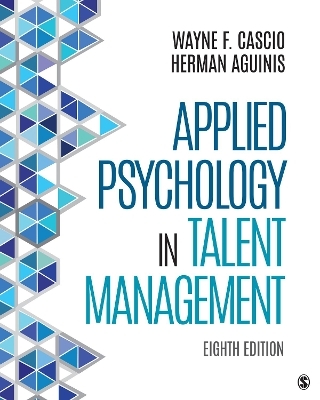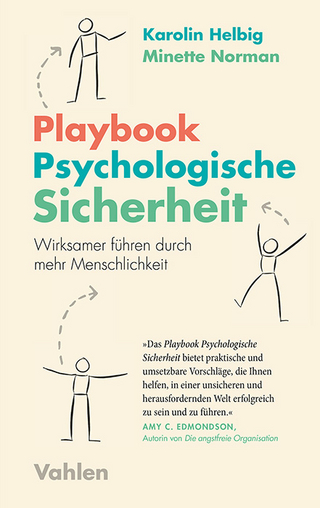
Applied Psychology in Talent Management
SAGE Publications Inc (Verlag)
978-1-5063-7591-5 (ISBN)
In Applied Psychology in Talent Management, world-renowned authors Wayne F. Cascio and Herman Aguinis provide the most comprehensive, future-oriented overview of psychological theories and how those theories impact people decisions in today’s ever-changing workplace. Taking a rigorous, evidence-based approach, the new Eighth Edition includes more than 1,000 new citations from more than 20 top-tier journal articles. The authors emphasize the latest developments in the field—all in the context of historical perspectives. Integrated coverage of technology, strategy, globalization, and social responsibility throughout the text provides students with a holistic view of the field and equips them with the practical tools to create productive, enjoyable work environments.
Wayne F. Cascio is a Distinguished University Professor Emeritus at the University of Colorado Denver. He is past chair of the Society for Human Resource Management Foundation and the Human Resources Division of the Academy of Management, past president of the Society for Industrial and Organizational Psychology, and a past member of the Academy of Management’s Board of Governors. He is a Fellow of the National Academy of Human Resources, the Academy of Management, the American Psychological Association, and the Australian Human Resources Institute. Professor Cascio received the Distinguished Career Award from the HR Division of the Academy of Management; an honorary doctorate from the University of Geneva, Switzerland; the Michael R. Losey Human Resources Research Award from the Society for Human Resource Management; the Distinguished Scientific Contributions Award from the Society for Industrial and Organizational Psychology; and, by a vote of 90 countries, the George Petitpas [Lifetime Achievement] Award from the World Federation of People Management Associations. In 2020 he received the inaugural Ulrich Impact Award from the HR Division of the Academy of Management for his research that links theory to practical applications, and he was also inducted into the Australian HR Institute’s Hall of Fame. In 2022 he received the Distinguished Service Award from the University of Colorado Board of Regents for his service to the state and to the nation. He is a former area and consulting editor of the Journal of International Business Studies (JIBS) and he also served as a senior editor of the Journal of World Business. He served as chair of the SHRM Certification Commission and a member of the Australian HR Institute’s National Certification Council, each for 8 years. He has consulted with various private- and public-sector organizations on six continents and periodically testifies as an expert witness in employment discrimination cases. Professor Cascio is an active researcher, writer, and speaker. He has published more than 200 articles and book chapters, and 33 books and delivered more than 800 presentations to professional and business audiences worldwide. His work is regularly cited in the business press. Professor Cascio earned his B.A. from Holy Cross College, his M.A. from Emory University, and his Ph.D. in industrial/organizational psychology from the University of Rochester. Herman Aguinis is the Avram Tucker Distinguished Scholar and Professor of Management at The George Washington University School of Business. His interdisciplinary research addresses research methods in the social and behavioral sciences and the acquisition and deployment of talent in organizations. In addition to his about 220 journal articles, 350 keynotes and presentations at professional conferences, and 200 invited presentations, he has published twelve books, including Regression Analysis for Categorical Moderators, Performance Management, and Applied Psychology in Talent Management (with W.F. Cascio). He served as Editor-in-Chief of Organizational Research Methods and received the Academy of Management Research Methods Division Distinguished Career Award for lifetime contributions. He is a three-time recipient of the Academy of Management Research Methods Division Robert McDonald Advancement of Organizational Research Methodology Award, recognizing the best article published in the preceding five years. Also, he received career awards for research contributions from the Society for Industrial and Organizational Psychology and the Society for Human Resource Management, served as President of the Academy of Management, and has been inducted into The PhD Project Hall of Fame. He is a Fellow of the Academy of Management, the American Psychological Association, the Association for Psychological Science, and the Society for Industrial and Organizational Psychology. He serves or has served on the editorial board of 26 journals. The Web of Science Highly Cited Researchers Report has ranked him among the world’s 100 most impactful researchers in Economics and Business every year since 2018, and he has about 35,000 LinkedIn and X followers. He is the recipient of the 2024 Academy of Management Diversity, Equity, and Inclusion Division Career Award for Scholarly Contributions. For more information, please visit https://www.hermanaguinis.com
Preface to the 8th Edition
Acknowledgments
About the Authors
Chapter 1: Organizations, Work, and Applied Psychology
The Pervasiveness of Organizations
Differences in Jobs
Differences in Performance
A Utopian Ideal
Point of View
Personnel Psychology and Talent Management in Perspective
Globalization of Product and Service Markets
Impact on Jobs and the Psychological Contract
Effects of Technology on Organizations and People
Changes in the Structure and Design of Organizations
Changing Roles of Managers and Workers
Changing Demographics
Implications for Organizations and Their People
Plan of the Book
Chapter 2: The Law and Talent Management
The U.S. Legal System
Legal Systems Outside the United States
Unfair Discrimination: What Is It?
Legal Framework for Civil Rights Requirements
The U.S. Constitution—Thirteenth and Fourteenth Amendments
Civil Rights Acts of 1866 and 1871
Equal Pay for Equal Work Regardless of Sex
Equal Pay Act of 1963
Equal Pay for Jobs of Comparable Worth
Equal Employment Opportunity: Title VII of the Civil Rights Act of 1964
Nondiscrimination on the Basis of Race, Color, Religion, Sex, or National Origin
Retaliation, and Employment Advertising
Suspension of Government Contracts and Back-Pay Awards
Exemptions to Title VII Coverage
Age Discrimination in Employment Act of 1967 (as Amended in 1986)
Immigration Reform and Control Act of 1986
Americans with Disabilities Act of 1990 (as Amended in 2008)
Provisions of the ADA
Enforcement of the ADA
Civil Rights Act of 1991
Monetary Damages and Jury Trials
Adverse Impact (Unintentional Discrimination) Cases
Protection in Foreign Countries
Racial Harassment
Challenges to Consent Decrees
Mixed-Motive Cases
Seniority Systems
Race Norming
Extension to U.S. Senate and Appointed Officials
Family and Medical Leave Act of 1993
Uniformed Services Employment and Reemployment Rights Act of 1994
Enforcement of the Laws—Regulatory Agencies
State Fair Employment Practices Agencies
Equal Employment Opportunity Commission
The Complaint Process
Office of Federal Contract Compliance Programs
Goals and Timetables
Employment Case Law—General Principles
Testing
Personal History
Sex Discrimination
Preventive Actions by Employers
Age Discrimination
“English Only” Rules—National Origin Discrimination?
Seniority
Preferential Selection
Chapter 3: People, Decisions, and the Systems Approach
Costs and Consequences of Decisions—A Way of Thinking
Organizations as Systems
A Systems View of the Staffing Process
Optimizing Staffing Investments
Optimizing Staffing Outcomes
A Systems View of the Broader Employment Process
Work Analysis
Strategic Workforce Planning
Recruitment
Initial Screening
Selection
Training and Development
Performance Management
Organizational Exit
Chapter 4: Criteria: Definitions, Measures, and Evaluation
Definition
Job Performance as a Criterion
Dimensionality of Criteria
Static Dimensionality
Dynamic or Temporal Dimensionality
Individual Dimensionality
Challenges in Criterion Development
Challenge #1: Job Performance (Un)Reliability
Challenge #2: Reliability of Job Performance Observation
Challenge #3: Dimensionality of Job Performance
Performance and Situational Characteristics
Environmental and Organizational Characteristics
Environmental Safety
Lifespace Variables
Job and Location
Extraindividual Differences and Sales Performance
Leadership
Steps in Criterion Development
Evaluating Criteria
Relevance
Sensitivity or Discriminability
Practicality
Criterion Deficiency
Criterion Contamination
Bias Due to Knowledge of Predictor Information
Bias Due to Group Membership
Bias in Ratings
Composite Criterion Versus Multiple Criteria
Composite Criterion
Multiple Criteria
Differing Assumptions
Resolving the Dilemma
Research Design and Criterion Theory
Distribution of Performance and Star Performers
Chapter 5: Performance Appraisal and Management
Purposes Served
Realities and Challenges of Performance Management Systems
Fundamental Requirements of Successful Performance Management Systems
Benefits of State-of-the-Science Performance Management Systems
Who Shall Rate?
Immediate Supervisor
Peers
Subordinates
Self
Clients Served
Appraising Performance: Individual Versus Group Tasks
Putting It All Together: 360-Degree Systems
Agreement and Equivalence of Ratings Across Sources
Judgmental Biases in Rating
Leniency and Severity
Central Tendency
Halo
Types of Performance Measures
Objective Measures
Subjective Measures
Rating Systems: Relative and Absolute
Relative Rating Systems (Employee Comparisons)
Rank Ordering
Paired Comparisons
Forced Distribution
Absolute Rating Systems
Essays
Behavioral Checklists
Forced-Choice System
Critical Incidents
Graphic Rating Scales
Behaviorally Anchored Rating Scales
Summary Comments on Rating Formats and Rating Process
Factors Affecting Subjective Appraisals
Evaluating the Performance of Teams
Rater Training
The Social, Emotional, and Interpersonal Context of Performance Management Systems
Performance Feedback: Appraisal and Goal-Setting Interviews
Communicate Frequently
Get Training in Appraisal
Judge Your Own Performance First
Encourage Subordinate Preparation
Use “Priming” Information
Warm Up and Encourage Participation
Judge Performance, Not Personality or Self-Concept
Be Specific
Be an Active Listener
Avoid Destructive Criticism and Threats to the Employee’s Ego
Set Mutually Agreeable and Formal Goals
Continue to Communicate and Assess Progress Toward Goals Regularly
Make Organizational Rewards Contingent on Performance
Chapter 6: Measuring and Interpreting Individual Differences
What Is Measurement?
Scales of Measurement
Nominal Scales
Ordinal Scales
Interval Scales
Ratio Scales
Scales Used in Applied Psychological Measurement
Selecting and Creating the Right Measure
Steps for Selecting and Creating Measures
Determining a Measure’s Purpose
Defining the Attribute
Developing a Measure Plan
Writing Items
Conducting a Pilot Study and Traditional Item Analysis
Conducting an Item Analysis Using Item Response Theory
Selecting Items
Determining Reliability and Gathering Evidence for Validity
Revising and Updating Items
Selecting an Appropriate Measure: Test-Classification Methods
Content
Administration
Standardized and Nonstandardized Tests
Scoring
Further Considerations in Selecting a Test
Reliability as Consistency
Estimation of Reliability
Test—Retest
Parallel (or Alternate) Forms
Internal Consistency
Kuder-Richardson Reliability Estimates
Split-Half Reliability Estimates
Stability and Equivalence
Interrater Reliability
Summary
Interpretation of Reliability
Range of Individual Differences
Difficulty of the Measurement Procedure
Size and Representativeness of Sample
Standard Error of Measurement
Scale Coarseness
Generalizability Theory
Interpreting the Results of Measurement Procedures
Looking to the Future: Anticipated Innovations in Applied Psychological Measurement
Chapter 7: Validation and Use of Individual-Differences Measures
Relationship Between Reliability and Validity
Evidence of Validity
Content-Related Evidence
Criterion-Related Evidence
Predictive Studies
Concurrent Studies
Requirements of Criterion Measures in Predictive and Concurrent Studies
Factors Affecting the Size of Obtained Validity Coefficients
Range Enhancement
Range Restriction
Position in the Employment Process
Form of the Predictor–Criterion Relationship
Retesting
Construct-Related Evidence
Construct Validation Process
An Illustration of Construct Validation
Cross-Validation
Empirical Cross-Validation
Statistical Cross-Validation
Comparison of Empirical and Statistical Strategies
Gathering Validity Evidence When Local Validation Is Not Feasible
Synthetic Validity
Test Transportability
Validity Generalization
How to Conduct a VG Study
Refinements to VG Techniques
Challenges in Conducting a VG Study
Empirical Bayesian Analysis
Application of Alternative Validation Strategies: Illustration
Chapter 8: Fairness in Employment Decisions
Assessing Differential Validity
Differential Validity and Adverse Impact
Differential Validity: The Evidence
Assessing Differential Prediction and Moderator Variables
Differential Prediction: The Evidence
Problems in Testing for Differential Prediction
Using Meta-Analysis to Assess Differential Prediction
Suggestions for Improving the Accuracy of Slope-Based Differential Prediction Assessment
Further Considerations Regarding Adverse Impact, Differential Validity, and Differential Prediction
Minimizing Adverse Impact Through Test-Score Banding
Fairness and the Interpersonal Context of Employment Testing
Fair Employment and Public Policy
Chapter 9: Analyzing Jobs and Work
Definition, Professional Standards
Terminology
Aligning Method With Purpose
Choices
Defining the Job
Job Specifications
Reliability and Validity of Work Analysis Information
Obtaining Information About Jobs and Work
Direct Observation and Job Performance
Interview
SME Panels
Questionnaires
The Position Analysis Questionnaire
Fleishman Job Analysis Survey
Critical Incidents
Other Sources of Job Information and Job Analysis Methods
The Job Analysis Wizard
Incorporating Personality Dimensions Into Job Analysis
Strategic or Future-Oriented Work Analyses
Competency Models
Work Analysis for Star Performers
Cognitive Task Analysis
Occupational Information—From the Dictionary of Occupational Titles to O*NET®
Multiple Windows
Common Language
Taxonomies and Hierarchies of Occupational Descriptors
The O*NET® Content Model
Chapter 10: Strategic Workforce Planning
What Is Strategic Workforce Planning?
Strategic Business and Workforce Plans
Levels of Planning
The Strategic Planning Process
An Alternative Approach
Payoffs From Strategic Planning
Relationship of HR Strategy to Business Strategy
Talent Inventory
Information Type
Uses
Forecasts of Workforce Supply and Demand
External Workforce Supply
Internal Workforce Supply
From Predictable to Unpredictable Supplies of Labor
Leadership-Succession Planning
Chief Executive Officer (CEO) Succession
Workforce Demand
Pivotal Jobs
Assessing Future Workforce Demand
How Accurate Must Demand Forecasts Be?
Integrating Supply and Demand Forecasts
Matching Forecast Results to Action Plans
Control and Evaluation
Sampling and Measuring Performance
Identifying an Appropriate Strategy for Evaluation
Responsibility for Workforce Planning
Chapter 11: Recruitment
Recruitment Planning
Internal Recruitment
External Recruitment
Staffing Requirements and Cost Analyses
Source Analysis
Operations
External Sources for Recruiting Applicants
Managing Recruiting Operations
Measurement, Evaluation, and Control
Job Search From the Applicant’s Perspective
Realistic Job Previews
Chapter 12: Selection Methods
Personal History Data
Weighted Application Blanks
Biographical Information Blanks
Résumés
Credit History
Response Distortion in Personal History Data
Validity of Personal History Data
Bias and Adverse Impact
What Do Biodata Mean?
Recommendations and Reference Checks
Polygraph Tests
Honesty Tests
Evaluation of Training and Experience
Drug Screening
Computer-Based Screening
Employment Interviews
Response Distortion in the Interview
Reliability and Validity
Factors Affecting the Decision-Making Process
Social/Interpersonal Factors
Cognitive Factors
Individual Differences
Effects of Structure
Summary of Evidence-Based Suggestions for Improving the Interview Process and Outcome
The Future Is Now: Technology and Big Data
Social Media
Mobile and Web-Based Selection
Computer Scoring of Text
Remote Interviewing
Virtual Reality Technology
Chapter 13: Managerial Selection Methods
Criteria of Managerial Success
Global Criterion Measures
The Importance of Context
Instruments of Prediction
Cognitive Ability Tests
Controversial Issues in the Use of Cognitive Ability Tests
A Recommendation to Address the Controversy
Objective Personality Inventories
Why and When Does Personality Predict Performance?
Response Distortion in Personality Inventories
Strategies to Mitigate Response Distortion
Leadership Ability Tests
Motivation to Manage
Personal History Data
Peer Assessment
Work Samples of Managerial Performance
Leaderless Group Discussion
Reliability
Validity
Effects of Training and Experience
The In-Basket Test
The Business Game
Situational Judgment Tests
Assessment Centers
Assessment Center: The Beginnings
Level and Purpose of Assessment
Duration and Size
Assessors and Their Training
Performance Feedback
Reliability of the Assessment Process
Validity
Fairness and Adverse Impact
Assessment Center Utility
Potential Problems
Combining Predictors
Chapter 14: Decision Making for Selection
Personnel Selection in Perspective
Classical Approach to Personnel Selection
Efficiency of Linear Models in Job-Success Prediction
Unit Weighting
Suppressor Variables
Data-Combination Strategies
Types of Strategies
Effectiveness of Alternative Data-Combination Strategies
The Role of Subjective Judgment
Alternative Prediction Models
Multiple-Regression Approach
Multiple-Cutoff Approach
Setting a Cutoff
Angoff Method
Expectancy Charts
Multiple-Hurdle Approach
Extending the Classical Validity Approach to Selection Decisions: Decision-Theory Approach
The Selection Ratio
The Base Rate
Utility Considerations
Evaluation of the Decision-Theory Approach
Understanding Outcomes of Selection Decisions: Utility Analysis
The Naylor–Shine Model
The Brogden–Cronbach–Gleser Model
Further Developments of the Brogden–Cronbach–Gleser Model
Alternative Methods of Estimating SDy
Integration of Selection Utility With Capital-Budgeting Models
Application of the Brogden–Cronbach–Gleser Model and the Need to Scrutinize Utility Estimates
Top Scorers May Turn Down the Offer
There Is a Discrepancy Between Expected and Actual Performance Scores
Economic Factors Affect Utility Estimates
Top Management May Not Believe the Results
Utility and Usefulness
The Strategic Context of Personnel Selection Decisions
Chapter 15: Training and Development: Considerations in Design
Factors Driving the Increasing Demand for Workplace Training
Training and Development Activities: What Are They?
Training Design
Characteristics of Effective Training
Additional Determinants of Effective Training
Fundamental Requirements of Sound Training Practice
Defining What Is to Be Learned
Interactions of Training and Development With Other Systems
Assessing Training Needs
Organization Analysis
Demographic Analysis
Operations Analysis
Individual Analysis
Rapid Prototyping
Specifying Training Objectives
Creating an Optimal Environment for Training and Learning
Team Training
Learning and Individual Differences
Trainability and Individual Differences
Principles That Enhance Learning
Goal Setting
Behavior Modeling
Meaningfulness of the Material
Practice
Active Practice
Overlearning
Length of the Practice Session
Feedback
Transfer of Training
Chapter 16: Training and Development: Implementation and the Measurement of Outcomes
Categories of Training and Development Methods
Presentation Methods
Hands-On Methods
Group-Building Methods
Technology-Based Training
Technique Selection
Measuring Training and Development Outcomes
Why Measure Training Outcomes?
Essential Elements of Measuring Training Outcomes
Criteria
Time
Types of Criteria
Levels of Criteria
Additional Considerations in Measuring Training Outcomes
Strategies for Measuring Training Outcomes in Terms of Financial Impact
An Illustration of Utility Analysis
Why Not Hold All Training Programs Accountable Strictly in Economic Terms?
Influencing Managerial Decisions With Program-Evaluation Data
Classical Experimental Designs
Design A
Design B
Design C
Design D
Limitations of Experimental Designs
Quasi-Experimental Designs
Design E
Design F
Design G
Design H
Statistical, Practical, and Theoretical Significance
Logical Analysis
Chapter 17: International Dimensions of Talent Management
Capitalism in the 21st Century
Globalization and Culture
Vertical and Horizontal Individualism and Collectivism
Country-Level Cultural Differences
Theoretical and Methodological Developments in the Study of Culture
The Globalization of Psychological Measurement
Transporting Psychological Measures Across Cultures
Terminology
Identification of Potential for International Management and Cultural Competence
Selection for International Assignments
General Mental Ability
Personality Characteristics and Expatriate Success
Other Characteristics Related to Success in International Assignments
Cross-Cultural Training
Performance Management
Performance Criteria
Who Should Assess Expatriate Performance?
Performance Feedback
Repatriation
Planning
Career Management
Compensation
Chapter 18: Organizational Responsibility and Ethical Issues in Talent Management
Organizational Responsibility: Definition and General Framework
Organizational Responsibility: Benefits
Organizational Responsibility: Implementation and the Role of Human Resource Management Research and Practice
Employee Privacy
Safeguarding Employee Privacy
Fair Information Practice in the Information Age
Employee Searches and Other Workplace Investigations
Testing and Evaluation
Obligations to One’s Profession
Obligations to Those Who Are Evaluated
Obligations to Employers
Individual Differences Serving as Antecedents of Ethical Behavior
Ethical Issues in Organizational Research
Ethical Issues at the Research-Planning Stage
Ethical Issues in Recruiting and Selecting Research Participants
Ethical Issues in Conducting Research: Protecting Research Participants’ Rights
Ethical Issues in Reporting Research Results
Strategies for Addressing Ethical Issues in Organizational Research
Science, Advocacy, and Values in Organizational Research
Appendix A: Scientific and Legal Guidelines on Employee Selection Procedures— Checklists for Compliance
Scientific Guidelines—Summary Checklist
Premise
Sources of Validity Evidence
Planning the Validation Effort and Analysis of Work
Criterion-Related Evidence of Validity
Feasibility
Criterion Development
Choice of Predictors
Choice of Participants
Data Analysis for Criterion-Related Validity
Evidence for Validity Based on Content
Evidence of Validity Based on Internal Structure
Generalizing Validity Evidence
Fairness and Bias
Operational Considerations
Initiating a Validation Effort
Selecting Assessment Procedures for the Validation Effort
Selecting the Validation Strategy
Selecting Criterion Measures
Data Collection
Data Analyses
Communicating the Effectiveness of Selection Procedures
Appropriate Use of Selection Procedures
Technical Validation Report
Administration Guide
Other Circumstances Regarding the Validation Effort and Use of Selection Procedures
Legal Guidelines on Employee Selection Procedures
1. Adverse Impact
A. Records Relating to Adverse Impact
B. Special Record-Keeping Provisions
C. Four-Fifths Rule
D. Adverse Impact When User Meets Four-Fifths Rule
E. Qualifying Circumstances Relating to Adverse Impact
2. Validation
A. General Information Regarding Validity
B. Identifying Information
C. Job Analysis
D. Professional Control
3. Criterion-Related Validity
A. Sample
B. Criterion Measures
C. Fairness of Criterion Measures
D. Results
E. Corrections and Categorization
F. Concurrent Validity
G. Prediction of Performance on Higher-Level Jobs
H. Fairness
4. Content Validity
A. Relevance of a Content Validity Strategy
B. Relation Between Selection Procedure and Work Behaviors
C. Knowledge, Skills, and Abilities
D. Adequacy of Simulation
E. Training
5. Construct Validity
6. Validity Generalization
7. Application
A. Use of Selection Procedures
B. Test Administration
C. Selection Decisions
D. Reduction of Adverse Impact
E. Currency, Interim Use
Appendix B: An Overview of Correlation and Linear Regression
The Concept of Correlation
The Concept of Regression
Making Predictions Based on Multiple Predictors
Predictive Accuracy of Multiple Regression
Appendix C: Decision Trees for Statistical Methods
References
Author Index
Subject Index
| Erscheinungsdatum | 31.08.2018 |
|---|---|
| Verlagsort | Thousand Oaks |
| Sprache | englisch |
| Maße | 203 x 254 mm |
| Gewicht | 1520 g |
| Themenwelt | Geisteswissenschaften ► Psychologie ► Arbeits- und Organisationspsychologie |
| Wirtschaft ► Betriebswirtschaft / Management ► Personalwesen | |
| ISBN-10 | 1-5063-7591-X / 150637591X |
| ISBN-13 | 978-1-5063-7591-5 / 9781506375915 |
| Zustand | Neuware |
| Informationen gemäß Produktsicherheitsverordnung (GPSR) | |
| Haben Sie eine Frage zum Produkt? |
aus dem Bereich



